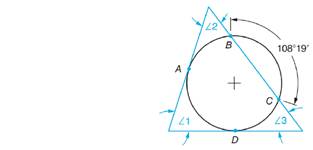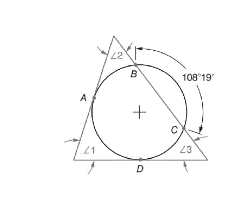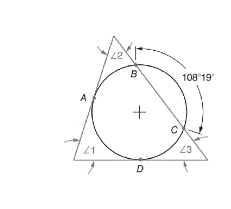
Concept explainers
Solve the following exercises based on Principles 18 through 21, although an exercise may require the application oftwo or more of any of the principles. Where necessary, round linear answers in inches to 3 decimal places and millimeters to 2 decimal places. Round angular answers in decimal degrees to 2 decimal places and degrees and minutes to the nearest minute.
a. If
(1) ∠1
(2) ∠2
(3) ∠3
b. If
(1) ∠1
(2) ∠2
(3) ∠3

(a)
The values of angles
Answer to Problem 22A
The values of angles are
Explanation of Solution
Given information:
Given figure is

Calculation:
The angle which is formed at a point on outside a circle by two tangents, two secants or a secant and a tangent is equal to one half the difference of arcs intercepted by the tangents or secants.
Let us first calculate the value of arc AD,
The total angle subtended by the entire circular arc on the center is 360o.
Now,
Now, for calculating angle 2,
Similarly,
Now, for calculating angle 3,
Similarly,
Conclusion:
Thus, the values of angles are
(b)
The values of angles
Answer to Problem 22A
The values of angles are
Explanation of Solution
Given information:
Given figure is

Calculation:
The angle which is formed at a point on outside a circle by two tangents, two secants or a secant and a tangent is equal to one half the difference of arcs intercepted by the tangents or secants.
Let us first calculate the value of arc AB,
The total angle subtended by the entire circular arc on the center is 360o.
Now,
Now, for calculating angle 2,
Similarly,
Now, for calculating angle 3,
Similarly,
Conclusion:
Thus, the values of angles are
Want to see more full solutions like this?
Chapter 54 Solutions
EBK MATHEMATICS FOR MACHINE TECHNOLOGY
- No chatgpt plsarrow_forwardcan you help me solve the parts and show workings pleasearrow_forwardSuppose that a room containing 1300 cubic feet of air is originally free of carbon monoxide (CO). Beginning at time t = 0, cigarette smoke containing 4% CO is introduced into the room at a rate of 0.8 cubic feet per minute. The well-circulated smoke and air mixture is allowed to leave the room at the same rate. Let A(t) represent the amount of CO in the room (in cubic feet) after t minutes. (A) Write the DE model for the time rate of change of CO in the room. Also state the initial condition. dA dt A(0) (B) Solve the IVP to find the amount of CO in the room at any time t > 0. A(t) (C) Extended exposure to a CO concentration as low as 0.00012 is harmful to the human body. Find the time at which this concentration is reached. t= minutesarrow_forward
- You buy a house for $210000, and take out a 30-year mortgage at 7% interest. For simplicity, assume that interest compounds continuously. A) What will be your annual mortgage payment? $ per year B) Suppose that regular raises at your job allow you to increase your annual payment by 6% each year. For simplicity, assume this is a nominal rate, and your payment amount increases continuously. How long will it take to pay off the mortgage? yearsarrow_forwardYour employer automatically puts 5 percent of your salary into a 401(k) retirement account each year. The account earns 8% interest. Suppose you just got the job, your starting salary is $40000, and you expect to receive a 2% raise each year. For simplicity, assume that interest earned and your raises are given as nominal rates and compound continuously. Find the value of your retirement account after 30 years Value = $arrow_forwardSuppose that a room containing 1300 cubic feet of air is originally free of carbon monoxide (CO). Beginning at time t = 0, cigarette smoke containing 4% CO is introduced into the room at a rate of 0.8 cubic feet per minute. The well-circulated smoke and air mixture is allowed to leave the room at the same rate. Let A(t) represent the amount of CO in the room (in cubic feet) after t minutes. (A) Write the DE model for the time rate of change of CO in the room. Also state the initial condition. dA dt A(0) (B) Solve the IVP to find the amount of CO in the room at any time t > 0. A(t) (C) Extended exposure to a CO concentration as low as 0.00012 is harmful to the human body. Find the time at which this concentration is reached. t= minutesarrow_forward
- Newton's Law of Cooling tells us that the rate of change of the temperature of an object is proportional to the temperature difference between the object and its surroundings. This can be modeled by the differential equation dT dt k(TA), where T is the temperature of the object after t units of time have passed, A is the ambient temperature of the object's surroundings, and k is a constant of proportionality. Suppose that a cup of coffee begins at 178 degrees and, after sitting in room temperature of 61 degrees for 12 minutes, the coffee reaches 171 degrees. How long will it take before the coffee reaches 155 degrees? Include at least 2 decimal places in your answer. minutesarrow_forwardcan you help me solve this question and show workings pleasearrow_forwardLet f : X → Y and g : Y → Z be two functions. Prove that(1) if g ◦ f is injective, then f is injective; (2) if g ◦ f is surjective, then g is surjective.arrow_forward
 Elementary Geometry For College Students, 7eGeometryISBN:9781337614085Author:Alexander, Daniel C.; Koeberlein, Geralyn M.Publisher:Cengage,
Elementary Geometry For College Students, 7eGeometryISBN:9781337614085Author:Alexander, Daniel C.; Koeberlein, Geralyn M.Publisher:Cengage, Elementary Geometry for College StudentsGeometryISBN:9781285195698Author:Daniel C. Alexander, Geralyn M. KoeberleinPublisher:Cengage Learning
Elementary Geometry for College StudentsGeometryISBN:9781285195698Author:Daniel C. Alexander, Geralyn M. KoeberleinPublisher:Cengage Learning Mathematics For Machine TechnologyAdvanced MathISBN:9781337798310Author:Peterson, John.Publisher:Cengage Learning,
Mathematics For Machine TechnologyAdvanced MathISBN:9781337798310Author:Peterson, John.Publisher:Cengage Learning,- Algebra & Trigonometry with Analytic GeometryAlgebraISBN:9781133382119Author:SwokowskiPublisher:Cengage
 Trigonometry (MindTap Course List)TrigonometryISBN:9781337278461Author:Ron LarsonPublisher:Cengage Learning
Trigonometry (MindTap Course List)TrigonometryISBN:9781337278461Author:Ron LarsonPublisher:Cengage Learning Trigonometry (MindTap Course List)TrigonometryISBN:9781305652224Author:Charles P. McKeague, Mark D. TurnerPublisher:Cengage Learning
Trigonometry (MindTap Course List)TrigonometryISBN:9781305652224Author:Charles P. McKeague, Mark D. TurnerPublisher:Cengage Learning





